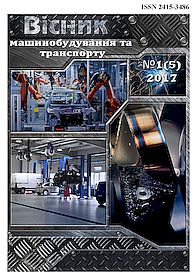MATERIAL FOR PHYSICAL MODELING OF PROCESSING OF METALS BY PRESSURE IN THE STATE OF SUPERPLASTICITY
Keywords:
superplasticity, material, modeling, hydrocarbons, high-speed, hardeningAbstract
The paper proposes to model the processes of superplastic deformation on optically transparent materials created on the basis of diene and vinylaromatic hydrocarbons, a polar plasticizer and an unstressed stabilizer.
The authors argue that before writing this article, the best material for modeling the processes of superplastic deformation was a tin alloy with 38% lead. The authors pointed out the advantages and disadvantages of the tin-lead alloy for modeling superplastic deformation. Advantages: simplicity of superplastic structure formation; high sensitivity of the flow stress to the strain rate; low flow stresses and large ultimate degrees of deformation of the alloy; the range of optimum superplasticity temperatures of eutectic Sn-38% Pb contains room temperature values, this eliminates the problem of sample heating.
Disadvantages: after intensive deformation, the Sn-38% Pb alloy stock must be stored in the freezer to avoid the growth of grains occurring in the alloy at room temperature; deformation of the alloy in an optically transparent tool allows one to observe in dynamics the change in the deformed state of the workpiece surface, for this, a coordinate grid must be applied to the surface; deformation of the inner layers of the alloy can be studied only after the deformation process has ceased and the workpiece is subsequently divided into parts.
The article presents examples of the chemical composition of new materials: base (content of the component - 100 parts by weight) - butadiene styrene, isoprene-styrene, butadiene-α-methylstyrene; Stabilizer (content of the component - 0.5 parts by weight) - 2,6-di-tert-butyl-4-methylphenol; Polar plasticizer (content of the component - 5 - 40 parts by weight) - dibutyl phthalate, dibutyl sebacate. The authors showed that the introduction of a polar plasticizer reduces the stress of the flow of materials (from 6.5 to 0.1 MPa), changes the elongation to break (in the range of 615 to 145 %), and the relative residual deformation after the fracture (in the range 18-56 %). A slight change in the content of the plasticizer allows one to model either the behavior of an alloy with a different superplastic structure or different temperature conditions of deformation. The deformation of samples from block copolymers is characterized by a high velocity sensitivity of the flow stress, the velocity sensitivity coefficient m at the strain rates of 10-3-10-4 s-1 has values in the range 0.26-1.00 and a maximum value in the same range of strain rates, as for metallic materials.
A slight change in the content of the plasticizer allows one to model either the behavior of an alloy with a different superplastic structure or different temperature conditions of deformation.
With the help of a grid drawn on the diametric plane of such samples and video recording of the deformation process, qualitative and quantitative changes can be analyzed throughout the sample volume at any time.
References
2. Васин Р. А. Введение в механику сверхпластичности. Часть 1 / Р. А. Васин, Ф. У. Еникеев. – Уфа : ГИЛЕМ, 1998. – 280 с.
3. Воронцов А. Л. Теория и расчеты процессов обработки металлов давлением : в 2 т. Т. 1 / А. Л. Воронцов. – М. : МГТУ им. Баумана, 2014. – 396 с.
4. Рудской А. И. Механика динамической сверхпластичности алюминиевых сплавов / А. И. Рудской, Я. И. Рудаев. – СПб. : Наука, 2009. – 218 с.
5. Коршак В. Ф. Структурно-фазовая релаксация в сверхпластичном эвтектическом сплаве Sn-38 % вес. Pb / В. Ф. Коршак, Ю. А. Шаповалов, Н. Н. Васеленко // Металлофизика и новейшие технологии. – 2015. – Т. 37, № 12. – С. 1633–1642.
6. А. с. 1247146. СССР. МПК B21J5/00. Материал с нелинейно-вязкими свойствами для физического моделирования процессов обработки металлов давлением в состоянии сверхпластичности / Цепин М. А., Смирнов О. М., Анищенко А. С. [и др.]. – Опубл. 30.07.1986, Бюл. №28. – 1 с.
7. А. с. 1389107. СССР. МПК B21J5/00. Материал для физического моделирования процессов обработки металлов давлением в состоянии сверхпластичности. / Цепин М. А., Доровских М. А., Кондратьев А. Н. [и др.]. – Опубл. 30.11.1987, Бюл. №44. – 5 с.
==========REFERENCES=========
1. Giuliano G. Superplastic forming of advanced metallic materials / G. Giuliano. – Oxford: Woodhead Publishing Limited, 2011. – 377 p.
2. Vasin R. A. Vvedenie v mekhaniku sverhplastichnosti. Chast 1 / R. A. Vasin, F. U. Enikeev. – Ufa : GILEM, 1998. – 280 p. (Rus).
3. Vorontsov A. L. Teoria i raschetyi protsessov obrabotki metallov davleniem. V 2 tomah. Tom 1 / A. L. Vorontsov. – M. : MGTU im. Baumana, 2014. – 396 p. (Rus).
4. Rudskoi A. I. Mekhanika dinamicheskoi sverhplastichnosti aliuminievyih splavov / A. I. Rudskoi, Ya. I. Rudaev. – Spb. : Nauka, 2009. – 218 p. (Rus).
5. Korshak V. F. Strukturno-fazovaya relaksatsia v sverhplastichnom evtekticheskom splave Sn-38 % ves. Pb. / V. F. Korchak, Yu. A. Chapovalov, N. N. Vaselenko // Metallofisika i noveychie tehnologii. – 2015, t. 37, №12, P. 1633-1642. (Rus).
6. A. s. 1247146. SSSR. MPK B21J5/00. Material s nelineyno-vyazkimi svoistvami dlya fizicheskogo modelirovanya protsessov obrabotki metallov davleniem v sostoyanii sverhplastichnosti / Tsepin M. A., Smirnov O. M., Anishchenko A. S. [i dr.]. – Opubl. 30.07.1986, Byul. №28. – 1 p. (Rus).
7. A. s. 1389107. SSSR. MPK B21J5/00. Material dlya fizicheskogo modelirovanya protsessov obrabotki metallov davleniem v sostoyanii sverhplastichnosti / Tsepin M. A., Dorovskih M. A.,
Kondratyev A. N. [i dr.]. – Opubl. 30.11.1987, Byul. №44. – 5 p. (Rus).
Downloads
-
PDF (Русский)
Downloads: 173


